Pictured Above: LOW DISTURBANCE NO-TILL. Lewis Krueger’s 40-foot drill has 48 Cross Slot openers for seeding grains, soybeans and cover crops in 10-inch rows. By raising the front gangs, seeding can be switched to 20-inch rows.
Several years ago, Lewis Krueger wasn’t happy with the erosion taking place on many of the 700 acres he farms near Brillion, Wis. Along with the help of government conservation funding, he invested considerable dollars, time and effort into combatting soil loss problems in eroded areas and waterways.
“After seeing this unnecessary soil loss, we made the decision to go 100% no-till, along with seeding cover crops to stop the erosion,” he says. “There was just too much soil damage.”
As an example, NRCS data shows typical soil losses of as much as 5.2 tons per acre every year in many areas of northeastern Wisconsin. Even with conservative estimates, this erosion amounts to around $100 per acre of lost equity each year.
While Krueger and long-time farm manager Ken Smith were previously sold on its many benefits, they hadn’t committed to a 100% no-till program. A Great Plains no-till drill was previously used to seed winter wheat and soybeans and they were also doing some vertical tillage.
“The problem I see with vertical tillage is that you’re tilling 1½-2 inches deep right around the planting depth where you can reach moisture for rapid germination,” explains Krueger. “But when growing conditions turn dry, you have this very dry, worked soil. And with changing weather patterns and torrential downpours, this layer of soft, dry soil often tended to lift up and flow into our waterways.”
Less Soil Disturbance Needed
To eliminate these concerns, Krueger started searching for a low-disturbance no-till system that would reduce the farm’s erosion worries. “I basically looked the world over for the ultimate no-till system to reduce soil disturbance and eventually came across John Baker’s work in New Zealand with Cross Slot,” he says.
"All tires require no more than 12 pounds of pressure…"
Krueger became sold on Baker’s concept for placing seed and fertilizer at the proper soil depth with an ultra-low disturbance no-till drill. What Krueger particularly likes about the Cross Slot opener is that it features a vertical coulter with a half shoe running horizontally along each side for accurate side-by-side placement of seed and fertilizer.
“As the coulter cuts a vertical slice in the soil, the two inverted T-shaped shoes move through the ground in a horizontal fashion at whatever depth set for the planting unit for perfect placement of seed being blown in by the air system on a cart,” he says. “By comparison, other openers leave a vertical slot in the soil.
“With the horizontal shoes, working in heavy residue is not a concern and there are no tucking or hairpinning problems in the seed furrow.”
Consistent planting depth is controlled automatically with the needed amount of downpressure on each of the coulters and press wheels. Residue is folded back over the seed slot to reduce moisture loss, while providing seedling protection.
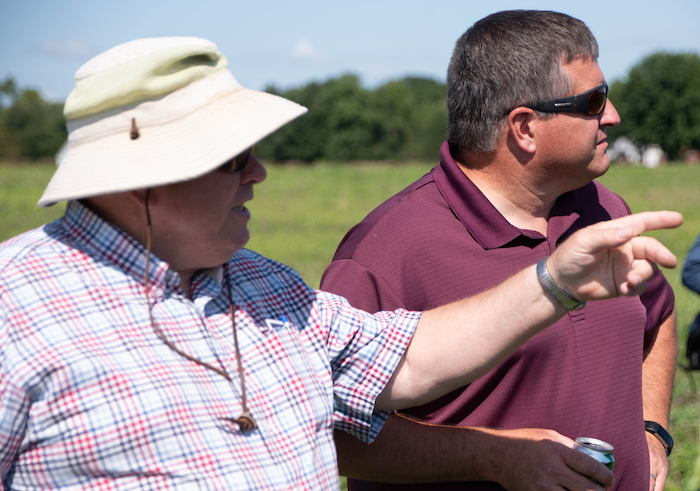
SAVING MOISTURE. Lewis Krueger (left) says sealing the seed and fertilizer trench offers a near-perfect environment for germination while trapping valuable moisture and water vapor for crop growth.
“On one side of the coulter, fertilizer is blown to the outside of that shoe with the seed going to the other side,” says Krueger. “The press wheels, which can be set for 300-500 pounds of downpressure — depending on ground moisture — push that slice of soil back to where it came from. Complete coverage and sealing of the trench leads to an ideal environment for seed germination as it allows moisture and water vapor to be trapped in the slot.
“After you’ve planted with this one pass ultra-low disturbance system, there is no disturbed soil, seed zone moisture is conserved, you’re building soil organic matter and you’re not tearing up any ground.”
Overcoming Compaction Concerns
The 40-foot Cross Slot drill Krueger uses is equipped with 48 openers for seeding small grains, soybeans and cover crops in 10-inch rows. It can also seed in 20-inch rows by raising the drill’s front gang of openers. The drill and cart is pulled with a 500 horsepower T9.565 New Holland tractor.
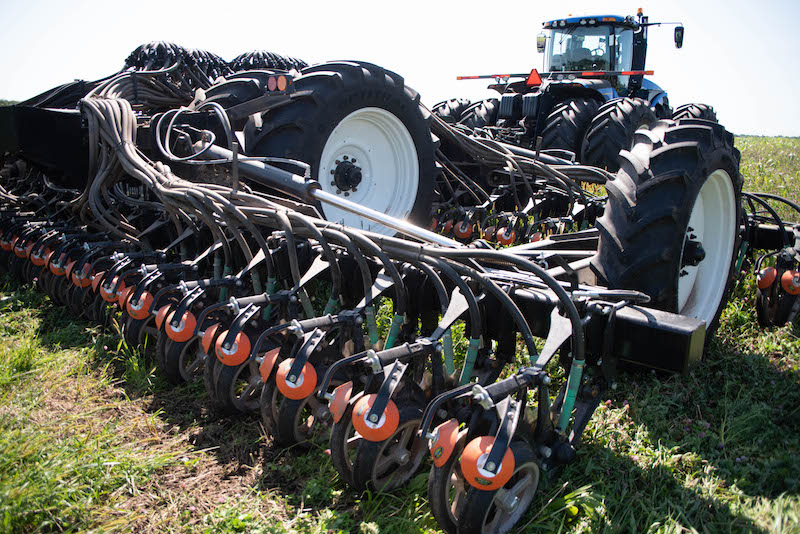
LOW PRESSURE TIRES. With the tractor, drill and a fully-loaded seed and fertilizer cart, there’s 132,000 pounds of weight. To reduce soil compaction, none of the tires require more than 12 pounds per square inch of pressure.
With the drill weighing 42,000 pounds, a 50,000-pound tractor and the 40,000-pound weight of a fully-loaded cart, there could be compaction concerns.
“Since any tire pressure over 15 pounds per square inch can lead to compaction, we designed the entire system so all of the tractor, drill and cart tires need no more than 12 pounds of pressure,” he says.
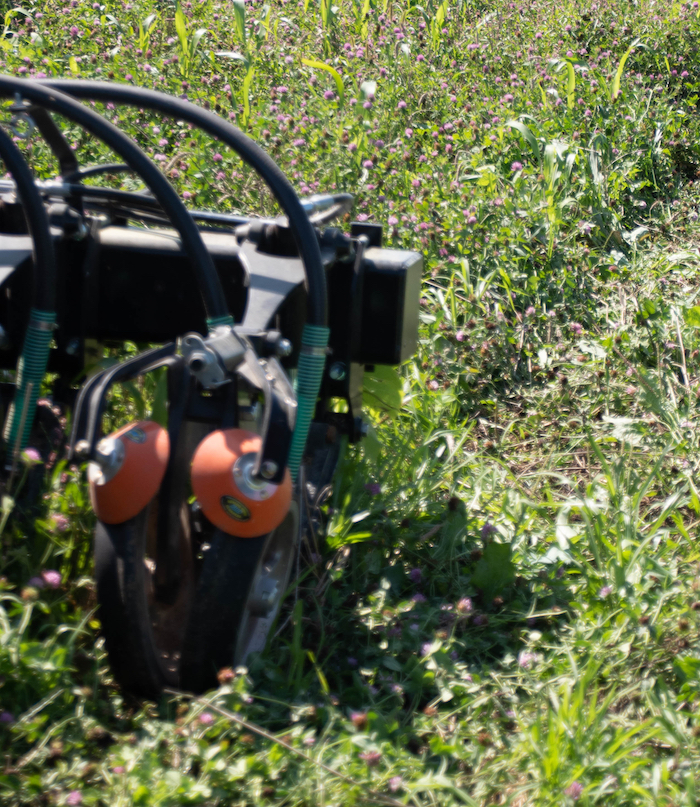
SOD SEEDING. Inverted t-shaped slots on the openers reduce soil disturbance and leave residue directly over the seed and fertilizer slots.
Krueger looked at using tracks with the tractor and no-till drill, but the economics didn’t make sense. With tracks on the tractor and drill, he figured he’d need another 80 tractor horsepower and an added track investment of $80,000.
Cover Crop Magic
Krueger seeds cover crops on as many acres as possible. “With cover crops, proper management is the key to no-till success,” he says. “Many cover crop species will bring nutrients up to the top where they can be used by your cash crops. After you spray out the cover crops or they seasonably die off, those nutrients are there for the next crop.”
"There are billions of nutrients sitting beneath the top few inches of soil…"
He likes the deep root channels that develop after cover crop decay, leading to more earthworms and improved water infiltration. These root channels allow growers to farm the entire soil profile with no-till rather than just the top 6-8 inches of ground.
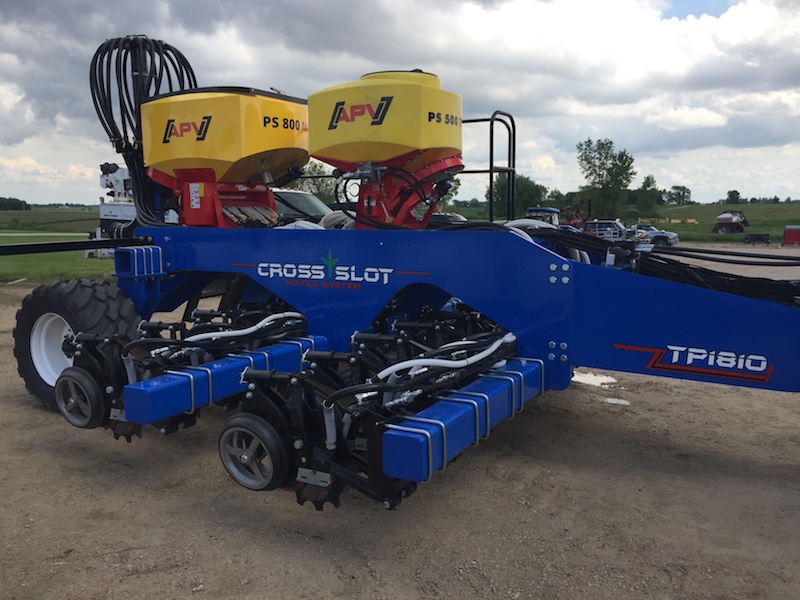
3-POINT HITCH SEEDER. Cross Slot has teamed up with Gruett's Inc., in designing, manufacturing and assembling a line of smaller Cross Slot seeders for the North American market. The Potter, Wis., farm equipment dealership has introduced several 8-20 foot wide Cross Slot TP models that connect to a tractor’s three-point hitch. The TP1810 model shown here is 15 feet wide with 18 Cross Slot openers for seeding in 10-inch rows. Gavin Porter, Cross Slot vice president of sales and marketing, is working with Gruett’s sales team. (Cross Slot USA, (509) 595-5782 or toll free: (888) 663-7773. Email: porter@CrossSlot.com.)
“That’s what we’ve got to do because there are plenty of nutrients sitting beneath the few top inches of soil where we’ve been farming in the past,” he says. “The more that growers no-till, seed cover crops, keep the ground covered all year long and develop more root mass, the softer, mellower and healthier soils their soils will become.
“With this combination of no-till management strategies, hard soils may become a thing of the past.”
FRANK COMMENTS...
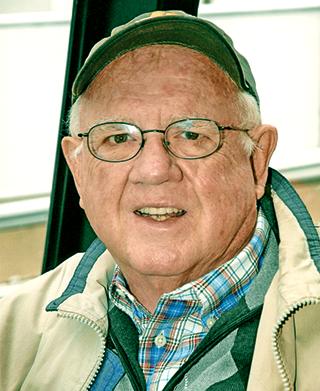
Manufacturers Saw Cross Slot as the “Cadillac” of No-Till Openers While a “Chevy” Product was Preferred
Too expensive to build with a limited market put the “kibosh” on licensing this New Zealand technology for major farm equipment manufacturers.
I’m not sure when I first met New Zealand ag engineer John Baker. But I recall signing him up as a speaker for the third annual National No-Tillage Conference, which was held in Indianapolis, Ind., in 1995.
At that event, the New Zealand ag engineer spoke about his newly-introduced Cross Slot no-till opener design and how he felt it would become a game-changer among growers interested in less soil disturbance with no-till.
Unlike other no-till openers, the Cross Slot openers leave residue directly over the seeded rows with almost no in-row soil disturbance. This is accomplished by using horizontal (inverted T-shaped) seed slots rather than the vertical slots found on most no-till drills and planters.
As it turned out, Baker’s technology was ahead of its time, and you could argue that this extremely low-disturbance concept continues to be slow to catch on, as evidenced by a limited number of no-till drill sales around the world.
However, cost was a major barrier to adoption for North American growers because the openers and drill frames were imported from New Zealand. Most Cross Slot drills were sold to growers located in in northwest states and western Canada who were looking for ways to conserve limited moisture while no-tilling under extremely dry conditions.
Biggies Said “No”
Back in the 1990s, Baker’s goal was to license the Cross Slot technology to one of the major players in the U.S. farm equipment market, such as John Deere, CaseIH, AGCO, New Holland, Caterpillar (at the time) or even a shortline manufacturer specializing in seeding equipment.
There seemed to be a consensus among potential farm equipment suppliers that the highly specialized Cross Slot design would be too expensive to build. As a result, the farm equipment majors felt they couldn’t be reasonably produced and adopted for North American markets other than for the limited no-till market in the 1990s.
"Folks are astonished when we tell them how easy it is to no-till into sod…"
Instead, planter and drill manufacturers preferred a much lower-cost product that could be used with all tillage systems. Even today, there’s still some thinking among a few equipment manufacturers that all you have to do is hang a few attachments on a conventionally-engineered drill or planter and it will work well under no-till conditions.
More than once over the years, I’ve heard folks refer to the Cross Slot opener as a “Cadillac” property in a limited market where manufacturer demand called for a “Chevrolet” level product.
T-Shaped Seed Slots
Baker defines his extremely low disturbance system as the ultimate form of no-till due to the opener’s inverted T-shaped seed slot that leaves residue over the seeded rows with very little in-row soil disturbance.
Baker says leaving undisturbed crop mulch over the row area traps water vapor in the soil, which helps the soil breathe and improves seed germination under dry conditions. With vertical seed slot openers, much of this valuable moisture escapes into the atmosphere.
Another benefit is preserving more carbon in the soil rather than discharging it as carbon dioxide into the atmosphere as occurs with high-disturbance seeding technology.
A No-Till Pioneer
Baker says the concept of what would eventually become no-till was researched as far back as the 1950s at the University of Massey in New Zealand. Baker, who did his graduate degree work on no-till at the school in the mid-1960s, says several research papers were published in the 1950s on no-tilling grasses and clover into the ashes of burned-over scrub on rough ground.
In 1995, Baker and several members of the ag engineering staff left the university to form Baker No-Tillage Ltd. Their goal was to turn the science behind the Cross Slot openers into the manufacturing of extremely low disturbance no-till drills.
Named as one of 43 “No-Till Legends” around the world by the No-Till Farmer editors in 2011, Baker has published more than 80 technical papers in his career on the science of no-till machinery and its interaction with the soil. Over the past three decades, Cross Slot research has been carried out by more than 50 university scientists, engineers and graduate students in New Zealand, Europe and the U.S.
Much of the research work that dealt with adopting the Cross Slot technology for North American conditions was done by Keith Saxton. The now retired USDA Agricultural Research Service ag engineer stationed at Washington State University in Pullman, Wash., worked at adopting the technology for extremely dry conditions faced by growers no-tilling in the northwestern states and the prairie provinces of western Canada.
Works Well In Sod
As a return speaker at the 2008 National No-Tillage Conference in Cincinnati, Baker urged no-tillers to cash in on the biological benefits of no-till by bringing hundreds of thousands of Conservation Reserve Program acres back into crop production. He offered attendees 11 suggestions for effectively no-tilling this ground that had been out of crop production for a number of years.
“It seems like everyone is astonished when you tell them no-tilling into sod is easy, but it can be done with the right equipment and management,” he told attendees. Looking back at when no-till picked up speed in the early 1970s, no-tilling into grass sod was quite popular in the Corn Belt.
In countries where no-till adoption has been slow and where government influence plays a major role in adopting new farming systems, Baker said some not-so-subtle nudges may be needed to get wider no-till acceptance.
"Time is running out to reverse serious topsoil damage throughout the word…"
“If it takes 500 years to rebuild 1-inch of topsoil at the rate at which we’re currently eroding the world’s arable land, time is running out to reverse the damage,” he said. “The science and practice of no-till has passed the point of no return, as no-till is within sight of becoming the most common system on the planet for seeding arable crops.”
Cross Slot for No-Till Planters?
For a number of years, Baker’s engineers have been working on adopting the Cross Slot opener technology for planting corn, soybeans, milo, cotton and other row crops.
While engineering progress seems to be moving slowly, some U.S.-based Cross Slot research has been done over the past several years with no-tilled corn by agronomist Joel Gruver at Western Illinois University at Macomb, Ill. In addition, some new opener design modifications are being developed by the New Zealand engineers.
At this point, the jury is still out as to when we might see the availability of the Cross Slot technology working with no-till planters.
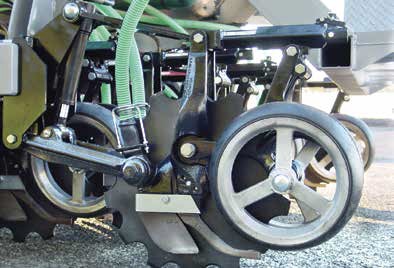
INDEPENDENT DOWNFORCE. Each Cross Slot opener is hydraulically controlled and individually controls seeding depth.
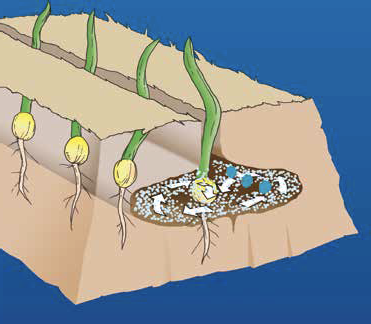
SIDE-BY-SIDE PLACEMENT With the inverted T-shaped seed opener that provides extremely low residue disturbance, valuable moisture is trapped near both seed and fertilizer.

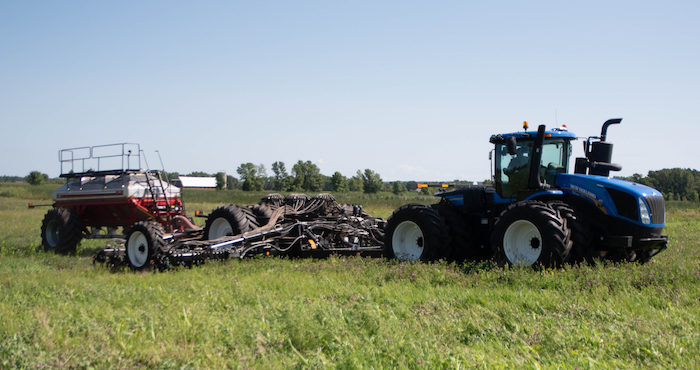






Post a comment
Report Abusive Comment